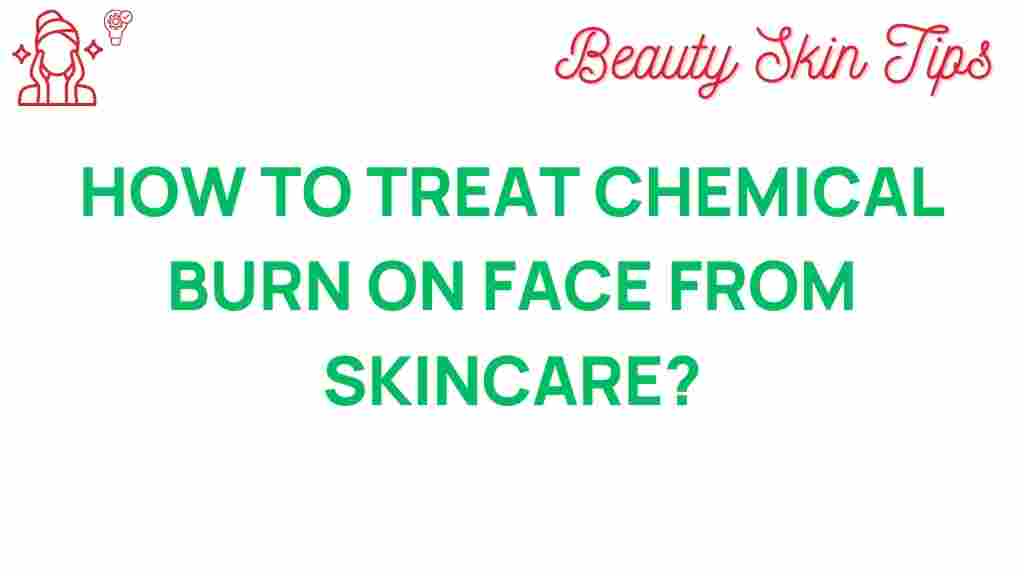Chemical Burn Treatment: Understanding and Responding Effectively
Chemical burns can occur with the use of certain skincare products, especially those containing strong acids, peels, or exfoliating agents. While our quest for radiant skin often leads us to try new products, it’s crucial to understand how to handle adverse reactions like chemical burns. This article will guide you through effective chemical burn treatment, ensuring you can respond quickly and appropriately to any skincare mishap.
What is a Chemical Burn?
A chemical burn occurs when skin comes into contact with a corrosive substance. In skincare, this might happen with products containing:
- Alpha Hydroxy Acids (AHAs)
- Beta Hydroxy Acids (BHAs)
- Retinoids
- Peroxide-based products
Symptoms of a chemical burn may include:
- Redness or irritation
- Swelling
- Blistering
- Pain or a burning sensation
Recognizing these symptoms early is critical for effective chemical burn treatment.
Immediate Steps for Chemical Burn Treatment
When you suspect a chemical burn, quick action is vital. Here’s a step-by-step guide to managing the situation:
Step 1: Rinse the Affected Area
The first step in chemical burn treatment is to rinse the affected area thoroughly with lukewarm water. This helps to dilute the chemical and remove it from the skin. Follow these guidelines:
- Rinse for at least 10-15 minutes.
- Avoid using hot water, as it can worsen irritation.
- If possible, remove any contaminated clothing or jewelry.
Step 2: Assess the Severity
After rinsing, evaluate the burn’s severity. Chemical burns are typically classified into three categories:
- First-degree burns: Affect only the outer layer of skin, causing redness and mild pain.
- Second-degree burns: Involve deeper layers, resulting in blisters and significant pain.
- Third-degree burns: Affect all layers of the skin, potentially leading to numbness and a leathery texture.
For first-degree burns, you may be able to treat it at home. However, second and third-degree burns require medical attention.
Step 3: Apply a Cold Compress
To alleviate pain and swelling, apply a cold compress to the affected area. Here’s how:
- Use a clean cloth soaked in cold water.
- Apply it for 10-15 minutes at a time.
- Repeat every hour as needed.
Step 4: Moisturize the Skin
Once the skin has cooled down, apply a gentle, fragrance-free moisturizer. Look for products containing:
- **Aloe Vera:** Known for its soothing properties.
- **Hyaluronic Acid:** Helps retain moisture.
- **Coconut Oil:** Offers hydration and has antibacterial properties.
Be cautious and avoid products with active ingredients or fragrances, as they may irritate the skin further.
Step 5: Over-the-Counter Relief
If you experience pain, consider using over-the-counter pain relievers such as ibuprofen or acetaminophen. Always adhere to the recommended dosage on the packaging.
Step 6: Monitor for Infection
Keep an eye on the burn for signs of infection, which may include:
- Increased redness or swelling
- Pus or discharge
- Fever
If you notice any of these symptoms, seek medical attention promptly.
Long-Term Care After Chemical Burns
Once the initial treatment is complete, it’s essential to care for your skin as it heals. Here are some tips for long-term care:
1. Avoid Further Irritation
Steer clear of harsh skincare products until the skin has fully healed. This includes:
- Exfoliants
- Retinoids
- Products with alcohol
2. Keep the Area Hydrated
Continue to moisturize the affected area regularly to prevent dryness and promote healing. Opt for gentle, hydrating products.
3. Protect from Sun Exposure
Sun exposure can worsen healing burns. Always apply a broad-spectrum sunscreen with SPF 30 or higher when exposed to sunlight. Remember to:
- Reapply every two hours.
- Wear protective clothing and sunglasses.
Troubleshooting Common Issues
Sometimes, despite taking precautions, chemical burn treatment may not go as planned. Here are common issues and how to address them:
Persistent Pain or Discomfort
If pain persists beyond a few days, it may indicate a more serious condition. Consult a healthcare professional for advice.
Skin Peeling or Flaking
Peeling skin can be a normal part of the healing process. However, if it becomes excessive or painful, seek medical advice.
Scarring Concerns
Some individuals may worry about potential scarring. To minimize this:
- Keep the area moisturized.
- Use silicone gel sheets or creams as recommended by a dermatologist.
When to Seek Medical Help
Not all chemical burns can be treated at home. Seek immediate medical attention if you experience:
- A large area of skin affected
- Signs of infection
- Severe pain
- Burns on the face, hands, or genitals
For comprehensive guidance, consult this resource for further information on chemical burn treatment.
Conclusion
Chemical burns from skincare products can be alarming, but understanding how to respond is crucial for effective treatment. By following the steps outlined above and being vigilant about your skin’s needs, you can ensure a smooth recovery process. Remember to always perform a patch test with new products to minimize risks in the future.
If you find yourself frequently experiencing adverse reactions, consider consulting a dermatologist to tailor a skincare routine to your specific needs.
For more information on skincare safety and product recommendations, check out this guide.
This article is in the category Treatments and created by BeautySkinTips Team
